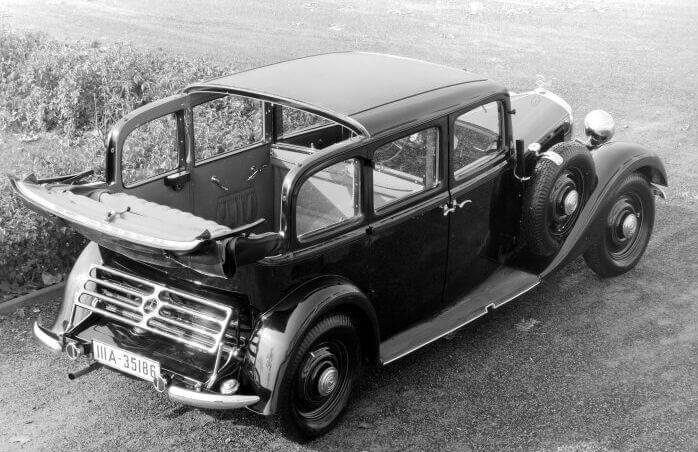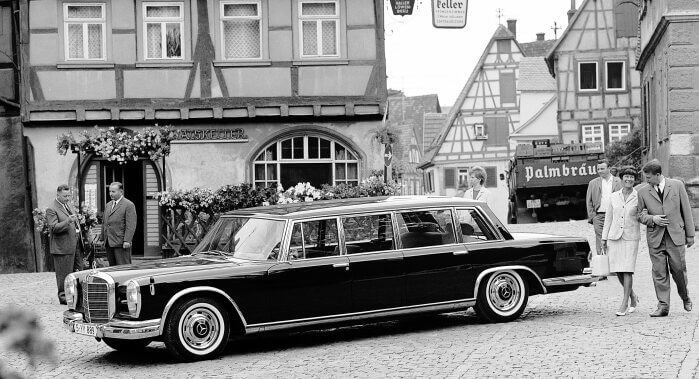- John Lennon, Pope Pius XI and the Japanese Emperor: They and many other stars, heads of state and private individuals have enjoyed “Pullman” Saloons by Mercedes-Benz
- Luxury and representation vehicles at the highest level
- “33 Extras”: Exhibits of automotive culture at the Mercedes-Benz Museum
Stuttgart. What do a leather cap, a canister of petrol and a scented tree ornament have in common? They are three of “33 Extras” on display at the permanent exhibition at the Mercedes-Benz Museum that draw visitors’ attention to fascinating details in the history of mobility and bring automotive culture to life. One of these stories explains the term “Pullman”.

The Pullman railway carriage of a tinplate model train set on the pedestal of the Mercedes-Benz 600 Pullman State Limousine (W 100) is a part of the “33 Extras” series in the permanent exhibition at the Mercedes-Benz Museum.
2/33: “Pullman”
1 – Name: “Pullman” was the original name for the comfortable and luxurious sleeper and lounge railway carriages 100 years ago. They were developed in the 1860s by American engineer and entrepreneur George Mortimer Pullman (1831 to 1897). The most demanding customers later wanted to travel with just as much exclusivity in a car. It makes sense then that the term “Pullman” was transferred to the car – which occurred in the early 20th century. The model railway carriage of a tinplate toy train set at the Mercedes-Benz Museum serves as a reminder of the origin of the highly exclusive Mercedes-Benz 600 Pullman State Limousine (W 100) from 1965 in “Collection 4: Gallery of Celebrities”.

Mercedes-Simplex 60 PS Touring Saloon by Emil Jellinek (1904, in the picture on the right) at the Mercedes-Benz Museum, “Legend 2: Mercedes – Birth of the Brand, 1900 to 1914”. Next to it an equally prestigious Benz 20/35 PS Landaulet from 1909.
2 – Origin: Comfortable travel at the highest level has played an important role in the history of Mercedes-Benz, the oldest luxury car brand in the world, since very early on. For example, for Emil Jellinek, the pioneer of the Mercedes brand: he had his 1904 Mercedes-Simplex 60 PS, the top model by Daimler at the time, refurbished as a luxurious touring saloon in 1907. Today the vehicle can be experienced in the room “Legend 2: Mercedes – Birth of the Brand, 1900 to 1914” at the Mercedes-Benz Museum. It is deserving of the name “Pullman”.
3 – Aspiration: For around 100 years and to this day, “Pullman” has stood for the highest level of excellence in vehicles with a Mercedes star. This was again underlined by the Mercedes-Maybach S 650 Pullman (222 model series; combined fuel consumption: 14.6 l/100 km; combined CO2 emissions: 330 g/km*) presented in March 2018.

4 – Tradition: The idea of the Mercedes-Benz Pullman as a name for the top category of automotive luxury and comfort is almost as old as the brand itself. The line of ancestors ranges from vehicles such as the Mercedes-Benz “Nürburg” Pullman Saloon (W 08) from 1928 and the Mercedes-Benz 770 “Grand Mercedes” Pullman Saloon (W 07) from the 1930s to the legendary Mercedes-Benz 600 Pullman (W 100) as a saloon and landaulet (1963 to 1981) as well as the luxury vehicles of the S-Class from the 140 model series until today

5 – Royalty: Every Mercedes-Benz Pullman ensures an appearance which is practically regal – complete with exclusive spaciousness, excellent travel comfort, top-class interior equipment in terms of technology and material, rear vis-à-vis seating and, of course, refined engine output without parallel.

Mercedes-Benz 770 “Grand Mercedes” Pullman Saloon belonging to Japanese Emperor Hirohito. The vehicle delivered in 1935 with the chrysanthemum emblem of the Emperor on the doors was one of half a dozen Pullman Saloons of the “Grand Mercedes” type bought by the Imperial Court in the 1930s. Today the luxurious representation vehicle with special protection is a part of the permanent exhibition at the Mercedes-Benz Museum, “Collection 4: Gallery of Celebrities”. Directly next to it: the no less prestigious Mercedes-Benz 770 “Grand Mercedes” Cabriolet F belonging to Kaiser Wilhelm II from 1932.
6 – Stars: Pullman cars by Mercedes-Benz have been popular amongst heads of state and monarchs since the 1920s – as well as with industrialists, celebrities and private customers with the very highest of demands. Examples: Pope Pius XI (Mercedes-Benz “Nürburg” 460 Pullman Saloon, 1930), Emperor Hirohito of Japan (Mercedes-Benz 770 “Grand Mercedes” Pullman Saloon, 1935) and John Lennon (Mercedes-Benz 600 Pullman Saloon, 1970).
7 – Special class: In more recent times the Pullman tradition has belonged to the 140 model series of the Mercedes-Benz S-Class. The refined vehicles are largely made by hand. This began in 1996 with the S 600 Pullman Saloon with a 290 kW (394 hp) twelve-cylinder engine.
8 – Passengers: “Pullman” is not just for celebrities. For example, the first diesel passenger vehicle built as standard in the world, the Mercedes-Benz 260 D (W 138), was also available as a generously dimensioned Pullman Saloon from 1936. Such a car can be found in the room “Legend 3: Upheavals – Diesel and Compressor” at the Mercedes-Benz Museum. The high degree of spaciousness can accommodate up to six passengers – as a taxi!

Mercedes-Benz 260 D (W 138) Pullman Saloon at the Mercedes-Benz Museum, “Legend 3: Upheavals – Diesel and Compressor”. The Pullman versions were particularly popular as taxis since they could accommodate six people.

Mercedes-Benz 260 D (W 138) Pullman Landaulet. The Pullman versions were particularly popular as taxis since they could accommodate six people.
9 – Payload: “Pullman” also denotes exceptional comfort for Mercedes-Benz commercial vehicles: that is what the letter “P” in the type abbreviation of the front-steering truck with the Mercedes star LP 315 stood for in 1955. The fascinating vehicles of this era include the LP 333 “Millipede” with two steered front axles, which can be seen in the permanent exhibition at the Mercedes-Benz Museum in the room “Collection 2: Gallery of Carriers”.

Mercedes-Benz LP 333 platform truck, called the “Millipede”, at the Mercedes-Benz Museum, “Collection 2: Gallery of Carriers”.

For a prestigious appearance: Mercedes-Benz 600 Pullman State Limousine (W 100) from 1967.
10 – As standard: The success story of the Pullman versions of luxurious Mercedes-Benz passenger vehicles can be seen in the representation vehicles in the middle of the 20th century: of the Mercedes-Benz 300 (W 189) from 1960 just three remain. The Mercedes-Benz 600 (W 100), on the other hand, was available from 1963 to 1981 as a Pullman Saloon and Pullman Landaulet with four or six doors as standard. Individualisation took centre stage: Mercedes-Benz not only fitted the rear seats longitudinally for the Beatle John Lennon, but also installed one of the best hi-fi systems for cars available at the time – for travel sound at a Pullman level.

Recent comments